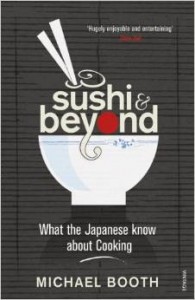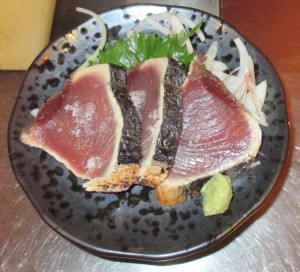 As a rule, the philosophy of cooking aims at the creation of new tastes that do not exist naturally… but Japanese cooking methods are antithetical to this philosophy. The ideal of Japanese cooking is to retain the natural tastes of food with the minimum of artificial processes. Thus sashimi… can be viewed as a representative product of the Japanese cooking philosophy. The basic concept of fish preparation in Japan is suggested by the following proverb: “Eat it raw first of all, then grill it, and boil it as the last resort.”
As a rule, the philosophy of cooking aims at the creation of new tastes that do not exist naturally… but Japanese cooking methods are antithetical to this philosophy. The ideal of Japanese cooking is to retain the natural tastes of food with the minimum of artificial processes. Thus sashimi… can be viewed as a representative product of the Japanese cooking philosophy. The basic concept of fish preparation in Japan is suggested by the following proverb: “Eat it raw first of all, then grill it, and boil it as the last resort.”
~ Michael Booth, Sushi & Beyond
Japan is a nation of islands, so, as in the Philippines, fish has always been a staple of the Japanese diet. In the seas around Japan, the fishing has, until recently, been plentiful. Sadly, poor fisheries management and severe over-fishing in the past century has caused a drop in the volume of catches and a subsequent hike in prices. Yet fish continues to be popular here, at any price.
Raw fish is served in many different countries. Since the beginning of time, the Filipinos have made kinilaw, which is similar to Peruvian ceviche. The French eat poisson cru, while the Italians prefer carpaccio or pesce crudo, and the Scandanavian gravadlax is delightful with vodka. The Fijians, Tongans and Tahitians like it with coconut milk, the Catalans, Koreans and Thais prefer it in a salad. The Japanese created sashimi.
Sashimi has been a favoured delicacy in Japan since the 17th century. In the Japanese cook’s bible “Japanese Cooking: a Simple Art,” Shizuo Tsuji describes sashimi as ‘the best loved food in Japan… [and] unbearably exotic.’ Fish – only the best quality – is the most popular meat for sashimi, but horse meat or chicken are also used. Sliced into bite-sized pieces, it is then dipped in soy sauce or smeared with wasabi. It may also be garnished with pickled ginger, a perilla leaf, like mint, or shredded daikon, the Asian white radish that appears in many Japanese dishes in a variety of forms.
Just about any seafood can be used to make sashimi, although the most popular fish are salmon and tuna, largely due to affordability and availability. But in Kochi, a largely rural island to the south of Osaka, the local specialty is katsuo, or bonito.
Katsuo is a plump, charcoal-coloured fish shaped like a torpedo, averaging the size of a man’s arm, fingertip to elbow. It is closely related to the tuna, but smaller and faster. Dried, fermented, and smoked, it becomes katsuobushi. Katsuobushi flakes are umami dense and a key ingredient in dashi, the base stock that is the cornerstone of Japanese cooking. Served as sashimi, it is, quite simply, perfection.
It is closely related to the tuna, but smaller and faster. Dried, fermented, and smoked, it becomes katsuobushi. Katsuobushi flakes are umami dense and a key ingredient in dashi, the base stock that is the cornerstone of Japanese cooking. Served as sashimi, it is, quite simply, perfection.
On my first night in Kochi, we gathered at an intimate sashimi bar in a narrow back street. The katsuo launched the meal, and we leaned across the bar to watch it being prepared. Seared briefly on the outside, it was then sliced into small steaks that were easily airlifted to the lips with chopsticks, via a nugget of wasabe.
The next day, our kind hosts drove us up into the mountains for fresh air and edifying scenery. On the return journey we stopped at a small and much-favoured local fish shop to buy a whole katsuo for dinner. We watched, fascinated, as the fishmonger carved off fins and head in swift, sure movements with what was obviously a bitingly sharp blade.
Sashimi sounds like such a simple dish. Slices of raw, unadorned fish on a plate. That can’t be too difficult, surely? Yet it takes time to perfect the skill of preparing sashimi properly.
 Sashimi knives are high maintenance tools that must be sharpened daily to ensure that the single beveled edge is always razor sharp. And the chef or fishmonger must be well versed in the texture of the fish he is dissecting, the way the muscles lie, and the thickness of the slice that best complements the fish and its flavour.
Sashimi knives are high maintenance tools that must be sharpened daily to ensure that the single beveled edge is always razor sharp. And the chef or fishmonger must be well versed in the texture of the fish he is dissecting, the way the muscles lie, and the thickness of the slice that best complements the fish and its flavour.
Swiftly skinned, deboned and filleted, our fish was packed on ice into a polystyrene box with a bag of left-over bits to make our own dashi. Then we headed home to create sashimi par excellence, or Katsuo no Tataki. This is a speciality of Kochi Prefecture. Apparently the late Spring catch (hatsu-gatsuo) was once considered so desirable that a popular saying suggested a man would trade his wife for a soupçon of katsuo. We have missed the Spring migration, but have made it in time for the modori gastuo, or the coming home for the winter, the fish meaty and succulent.
Smoked over a sweet-smelling rice straw fire in a barbecue in the driveway, and seared briefly in the leaping flames, the katsuo was then submerged in a large bowl of ice. (This will rapidly arrest the cooking process, and ensure the fish remains raw on the inside.) Once it had cooled, our chef sliced the fish carefully, gently, smoothly into small fillets, rather thicker than traditional sashimi, before arranging it them a wide, deep bowl with a ponzu sauce of citrus and sake. Garnished with ginger and radish sprouts and topped with a raw egg, Katsuo no Tataki is truly exotic. Truly heavenly. Perhaps it’s lucky I don’t have a wife to give away. How about a husband?
As seen in “Chop Soy” issue 2, 2015.
